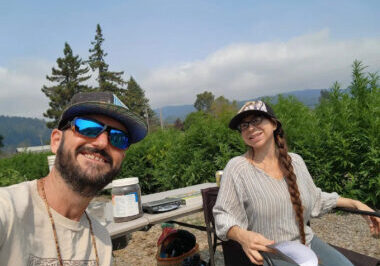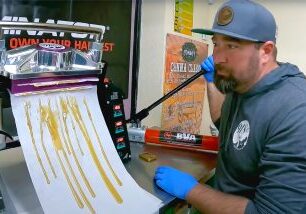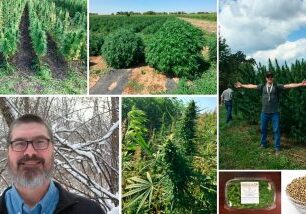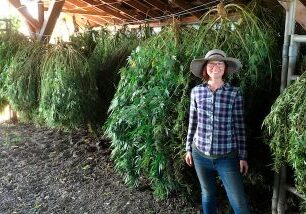In this episode, we’re going to be chatting about mechanical separation with Nick Rakkems of Rakkems Rosin.
Our hosts for this episode are Reed Preston, founder of Preston Hemp Co, and Dana Mosman, co-founder of Triminator.
Transcript
Intro: Welcome to own your harvest, powered by Triminator, global leader in cannabis harvesting equipment. We will be bringing new valuable insights from the front lines of the cannabis industry.
Giving direct access to our award-winning team, and educating you on a variety of topics. From field service to extraction. We have lined up some amazing guests for 2021 to kick off this new podcast. And now, here are your hosts, Reed Preston, founder of Preston Hemp co and Triminator ambassador, and co-founder of Triminator, Dana Mosman.
Reed Preston: Welcome to the own your harvest podcast. This is the ninth episode of our podcast series. I’m Reed Preston, founder of Preston Hemp co and an ambassador for Triminator. I’ll be hosting the series along with our Triminator co-founder Dana Mosman. This episode we’re going to be chatting about solventless extractions with Nick Rakkems.
Dana Mosman: Thanks, Reed. Yes, super excited to have Nick on here today. He’s a new brand ambassador for us and does a ton of cool and exciting stuff in the solventless space. So excited to hear from him, and get some tips and just dig into the extraction side.
Nick Rakkems: How y’all doing?
Reed: Good man, good to have you on here, it’s been a minute. Last time we were together was at the Ridge Sesh down in your neck of the woods, so good to see you again.
Nick: Yes, appreciate you guys having me on. Yes, that was a good time, I wish more of those sessions, and more of those gatherings happened of that caliber.
Reed: Yes, definitely.
Dana: That was up at San Juan, at Sweetland, that was the Sweetland one?
Nick: I believe so, yes.
Reed: So Nick, I mean I know we’ve spoke before, and I get to pick your brain sometimes. But just for everyone listening, anyone that doesn’t know you, like kind of what’s your background in the solventless world? Like how long have you been washing and pressing and doing the whole gig?
Nick: I think it’s been going on since about 2016 now. Started out well, I mean before that I was an automotive mechanic for about 20 years or so give or take, maybe longer than that now. My buddy told me about Rosin and didn’t really know about it. I knew about BHO, knew about open blasting, things of that nature, or like traditional Moroccan hash, but when he said rosin, I was like, you mean resin? I thought he was saying it wrong.
He’s like no, rosin, I’m like no, I’m not sure what that is. And he showed me Phil from soil growing solventless’s podcast on BC bubble man’s page the hash church. And he was using the hair straightener, smashing it down, and just like clicked in my head, it’s like I have a bearing press downstairs, looks like I need some heated plates, let’s figure it out. One of our good friends Joe he’s a fabricator, went to his shop, got some aluminum stock, made my first set of plates.
Found a heating controller through some China website, ordered that, and hooked everything up to my bearing press, and started hammering down. But right before that, just like everybody else, took the hair straightener from the girlfriend or the wife and dismantled it and JB welded it to the press, we did that, but that literally lasted about a week, and we realized that we needed something a little bit more heavy duty.
Plus the wife was pretty pissed off. So it’s not common for a dude to go and grab a $300 hair straightener to rip apart, smash nugs with. But that was pretty much the start of it, I saw that and it just kind of clicked in my head on what the tools I needed were, and how available they were to me. So started pressing flower, and then realized that was quickly not going to work the way I wanted it to.
So my buddy’s like have you tried hash, he’s like I’ve seen a few people pressing hash, he’s like well, I don’t even know how to make hash. He’s like you just get a bucket, a drill, a paddle, put the material in the ice water, and it’s these bags that you can get on amazon or from bubble man and you put all the material through there. And I was like all right cool, and the rest is pretty much history, I started doing that and never looked back.
Reed: Yes. One thing that I see you doing a lot which is pretty cool, I don’t see many other people, maybe I’m just ignorant to it, but I don’t see a lot of people washing like dried flour these days. I feel like everyone’s just into the fresh frozen like live rosin kick. But I see some of the work that you do on Instagram, just with regular hash, not fresh frozen material.
And like I’ve seen your comparisons too like the side by side of same strain, you did that, I forgot what strain it was you did it with, but you posted a photo of just the regular hash rosin and then the live rosin and they looked like nearly identical, couldn’t really see much of a difference. What do you have to like kind of say about that, because a lot of people just again preach just live rosin?
Nick: Yes. I mean at the end of the day, it’s a double-edged sword, especially within this community, you’re damned if you do, damned if you don’t type a situation with dealing with fresh frozen or driving material. But at the end of the day, one could say that you’re always going to get a more premium, higher quality product from whole plant fresh frozen product versus dried material.
There’s always going to be those people on the other hand saying that they prefer or like the terps off of dried material, or the consistency or the medicinal benefits, the high. I personally think on that level, like I don’t not like working with whole plant fresh frozen especially because our market now it kind of dictates that that’s going to be where everybody needs to go, just because of the cost and overhead of having to drive for two weeks or trim for two weeks or even longer than that.
So I feel like the communities and our industry is changing in that regard, but in my opinion, as far as the comparison, there’s always going to be something different, and in my opinion, better with the properly dry cured material that’s washing the hash and dried and pressing the rosin.
Just because in my train of thought, it just makes more sense to allow that plant to fully express the terpenes that are going to get expressed regardless, if it’s fresh frozen or not, those isolated terpenes that express at a lower temperature. But then you give the terpene content that does stay in those trichome heads a chance to fully develop, not necessarily fully mature and degrade into a darker oil that a lot of people will associate with dried material, but just this change.
And I’ve noticed that with fresh frozen, partially dried material, and then fully dried material, the terpene profile changes. Not necessarily in a bad way. Some might argue that, but others might say that it’s getting better with age, just like a wine or a whiskey. Also, the medicinal side of it too, the cannabinoids change, they get a lot of the THC or THCA will structurally change over to, convert over to THC.
Certain other cannabinoids will convert over, so you’re getting a totally different medical benefit than you would from fresh frozen, which is going to be a lot higher in THCA. There’s something to be said for it. I’m not a scientist, and I never claimed to be, and I wish I paid attention more in science class, especially nowadays, but it’s just a world of difference.
I mean, if you can do it right, that’s the big thing that I have a problem with, washing dried flour now, me and my wife have worked together long enough to dial in our process. But when you go to a different farmer who is focused on growing flower for flower and then dries it, it doesn’t really take in consideration what they’re doing to the trichome heads.
After it’s been cut down and harvested for drying purposes, then you’re fighting an endless battle at that point in time. And unless they are a hash maker themselves or been around hash makers or have grown for hash, they’re not going to really understand what I need to represent their trichomes the best to my ability. That’s another thing I’ve been kind of working on with people in regards to wanting processing done, toll processing, or doing collabs or whatnot. A lot of them will mention, we’ll talk about fresh frozen, but they’re like hey, we got these dry pounds sitting here in bins, is like okay cool? When was it cut down? About a month ago.
So it’s been in the bins for a month. Like what’s the temperature in the room? Oh 65, 75, it’s got to be under 65. I’m pretty much somewhat starting to explain my SOP for post-harvest process, but that’s part of it, and that makes a difference.
You’re wasting people’s time, whether it’s yourself, the farmer, or the maker, when the material that you expected to grow as flowered either didn’t yield or the market isn’t where it’s at, and now you don’t have anything else to do with it, so you decide you want to get it blasted or washed, and it’s been sitting for forever and not maintained properly.
It’s a struggle, but when it’s done right, it’s some of the most beautiful hash I’ve seen, and then with dry material and some of the most amazing flavor and best smoke. The high, the medical side for me is the biggest part that I noticed a huge difference in with fresh frozen and dried material.
Reed: A lot of like what you’re talking about too comes down to strains, right? Like strain-specific, grown just for hash and rosin production, right?
I’m sure you get people hitting you up saying oh, I want to do some toll processing or I want to do a split, and they’ve got not the right genetics and you’re just getting under a one percent yield or one percent yield, and it’s like at that point is it even worth it for you to really wash it or get into it, right?
Nick: It’s not, it’s really not. I mean, unless they have an abundance of it, and it’s unique. And if you have an abundance of something, it’s probably not unique. I mean, how much of a unique special strain that either dump or have a unique profile that you see in mass quantities? It’s very far and few between.
Unless you have these crazy five, 10-acre farms out here in California growing specifically that, which is also very far and few between. When it comes down to what we do, what I do as a maker, what others do as farmers, it’s all strain dependent, that’s your biggest variable. I mean, even strains themselves, if you’re doing from seed, you’re going to have 10, 20 different phenomes.
A majority of those phenome’s probably won’t wash, even though it’s from the same strain. Depends on what it was crossed with, depends on what genetics it took from its parents. I just washed a horchata, we did a mason jar test it looked like it was somewhere around the three to five percent rage and I washed it, expecting a good four or five percenter and I probably got a good two to three at best.
Quality of the hash is really nice and smells great, it smokes great as hash as melt, but the yield just wasn’t there. So do the horchata terpene profile is that loud enough and unique enough to keep around at such a low percentage? I mean, the markup on that end product, that rosin, if it was depending on the micron could be ridiculous. Just to cover your losses or your overhead for that specific light or those lights that you cut down.
Reed: Talking like microns, I mean, everyone’s got their preferences, like you do like a full spec like 45 to 159? Or you separate like 73, 120? Does it vary depending on what you’re washing?
Nick: It varies depending on what I’m washing, but I have kind of a rule of thumb, even if I watch the stream before I’ve just kind of made it more of a habit now to toss dried material, and it’s fresh enough dry material or like a partial dry, then my game plan kind of changes a little bit if I want to try to see if I can isolate some melt, depending on the batch size too. It will determine, will it be like my bags, what bags I’m using whether the ice extract bags or the rosin evolution all mesh bags.
The size of the batch will determine that as well. But as far as microns are concerned, if we’re talking about just fresh rosin, I’ll usually run for my first wash around the 45, 70, 90, 104, 120, pretty much all the bags, to see one where the hash lays, and what bags I don’t need to use. But also, to see where majority of my melt will be on that first or second wash. Sometimes I’ll mimic the first wash for the second wash, and then also based off of the batch size and I then open it up. So I know I have my melt, and then I just want to get my somewhat mixed micron or semi-full spectrum. These terms are getting pretty crazy now when everybody has their own definition of what it is.
I mean, at the end of the day, us as hash makers do not pull any type of full spec, because we’re not stripping all of the trichomes from the heads or from the plant material. I’ve trapped heads that were in the 220, some of the biggest trichome heads I’ve ever seen, but nobody keeps that. I’ve also gotten heads that did produce oil at the 25 and under, at the same time, majority people don’t keep that. So we can’t really use the term full spec.
But as far as that relays to what I do, typically I’ll do a 45, a 70, 73, and then a 120 or 160 and then a couple of double bagged, garbage bag so to speak of double 180 or double 220. Which I’ve been doing recently and noticing a big difference in is, and I kind of want to talk to these bag makers to figure out what’s going on. Because I don’t know, I’ve done it all the way down to 120 bag, and I’ve doubled up two 120 bags sometimes from the same manufacturer, sometimes from different manufacturers, and I will get shit in both bags.
So how’s that possible if they’re both the same micron, and you know how they say it’s 120. So anything 119 and below will fall through that. So if it’s falling through the first two, like 120 for example and it’s falling through that into the second 120, are the microns off on the first bag? It’s not really adding up.
And I’ve reversed them too and had the same shit, plus with a good rinsing, I still have stuff left over. So it’s very interesting to figure out what’s going on. Typically, my bags will be that way for the main reason of being able to keep my hash separate when it goes to the rosin press.
So a lot of people will think all right, let’s just run the 45 bag and the 180 bag or 190 bag and let it all fall under the 45, well what I’ve found with keeping the micron separate over time, you’ll have a 45 bike micron, a 73 micron, let’s say a 120 and a 160. Now you can keep that hash separate through the drying process in the trays or even if you’re air drying, which we can talk about later if you want, we get time.
From there you dry the hash, and now you can press the hash individually from the other microns as well. So now that gives you a little bit of a leg up in regards to your terpene profile, and also your color. Because what I’ve found over the last few years is that everything below your 73, 70 micron, and above your 120 usually 160 is going to have a slightly different unique terpene profile than the rest of the heads together. More often than not, a slightly different color.
You have like a nice blondish color for your star microns, which I consider the 70 90, and 120. That’s the term I like to use personally for my stuff. You’ll have a nice blonde color, but the 160 and the 45 might have a slightly darker amber tint to that. Well, if you mix those together to create your full spec, or you didn’t or you had all that fall into that 45-micron bag originally, now you’re pressing that all together, and you’re going to affect the color, and potentially, the chirping profile of your star micron, possibly negatively.
That doesn’t always happen, I’ve done those micron separations before and had every single micron smell amazing and look amazing. Right there just tells you that it gives me the option to mix them together to make a specific micron blend, or to keep them separate and maybe put those higher and lower microns to food grade, or to maybe diamond separation if it butters up. It just gives you more possibilities to work with, and also, at the end of the day, more SKUs too if you’re in the legal market.
Reed: Yes, for sure. I think like ultimately it kind of comes down to laziness in a way, because I feel like a lot of people are just like oh let’s do 45, 159, or 160 whatever.
Nick: I’ve done it, I mean, I’ve been there too.
Reed: That’s what I’m kind of saying. Like it seems like a lot more work just pulling the bags and also separating it, but at the same time, then like you said, at the end of the day you’ve got more options. And if it ends up pressing similar, mix it then, or.
Nick: Yes. I mean, that’s what I teach in the classes too, or explain on other podcasts and just anytime I’m talking whether it’s on my lives or whatnot. I learned that from bubble man, shout out to him for the knowledge bomb in that aspect. It just get clicked in my mind like yes, it is a little bit more work, you have to deal with more bags, you have to clean more bags, you have to kind of keep your mind on everything that’s going on.
Because there’s been times where I’ve gone to stack my bags again and grabbed a totally wrong bag, and mixed up the microns, and didn’t even pay attention. Or put a bag back in backwards which can contaminate shit. There are more things to think about, but at the end of the day, it gives you more tools in your toolbox for what you can achieve.
You might have a 45 that smells amazing, and the 160 that just smells like wet trim or wet grass or planty, earthy that’s not viable to mix with the rest. Well, now you can keep that separate. If you would have washed it all together and into a single bag, now you can’t separate it.
Reed: Right.
Nick: A little bit more work, but worth the time.
Reed: What about like prep for fresh frozen washes? Like do you recommend, like if you were to have someone that wanted to do a split with you, would you recommend them to like wet trim it, de-leaf it?
Obviously, you want to de-leaf as much as you can before harvest, right? But like have you seen like a lot of issues with chlorophyll, with people that are just like wet trimming too tight, or like anything along those lines?
Nick: Absolutely. I mean, like I said there’s a lot of farmers and especially my state of California, no disrespect to any of them, but there’s quite a majority of these farmers don’t understand the fresh frozen process, or how to even to grow for fresh frozen. So when it comes to harvesting for fresh frozen, I try to keep it as simple as possible. There’s no reason to, I don’t see a reason to wet trim. You’re losing yield by wet trimming, by forcing that bud onto a tabletop trimmer or any other trimming machine initially, when you’re processing for fresh frozen, just doesn’t make sense.
Me personally the less touching of the plant the better as it’s going from the stock to the bag to be frozen. I pretty much tell everybody that I talked to if you want to harvest refresh frozen, let’s do a mason jar test first to see if it’s even worth it, give us kind of a general idea of what the hash is that we have in there.
And then if it’s a positive outcome, when you’re ready to harvest check your trichomes one last time, make sure that they’re not super clear, that they’re starting to go opaque to amber, or mostly opaque at least. Because even as you’re trimming it or as you’re chopping everything down, those heads are still kind of converting. Same concept goes for like the partial dry.
But literally just fan leaves with stems, and then bucking into like a half-dollar-sized nug or smaller. And straight into a bag, do not suck the air out of the bag, don’t compress the bag, don’t vac seal the bag, just make it a nice little pillow. And I try to recommend about a thousand grams for every bag, it just helps me the maker out to calculate numbers and also kind of keeps the farmer continuing to go and not really having to focus on putting too much in there not enough.
And yes, there’s talks about flash freezing before it actually gets into a chest freezer, flash freezing with like dry ice and things of that nature, you can do that if you have the capabilities. But just getting it into a cold space or a freezer within four hours of harvesting is pretty much the most ideal situation you can have.
Transportations into a whole another conversation, but the initial harvest, it’s pretty much that simple. Like anything that has sugar or trichomes on it, you want to keep. You don’t want to table chop or wet trim those off or anything, just big leaves and stems and buck off.
Dana: Do you feel like the yields, like obviously feel like it’s positive for like trichome retention and stuff. Do you feel like the yields, because there’s a lot of work involved in the more material that’s in there, but for you, it’s worth it? Even though you have less potent material potentially?
Nick: Yes. I mean, depending on the praise on those specific genetics, how popular they are at the current time. Also thinking the other option too is the fact that if you do get something that doesn’t yield as good as far as fresh frozen, maybe have a couple of those that didn’t do well, well now you can start doing blends, in-house blends.
And that’s the one thing that I’ve been talking a lot with my counterparts for the last couple months now, is like do you like to wash blends of flour in the wash, or do you like to keep them separate until they get to rosin and then mix them there? So there’s still advantages if you get a low yield, but it goes back to the market and where those strains or those genetic, specific genetics hold their value at, and if they’re even worth putting on the market.
Dana: What are some of the pros and cons of blending in the wash, versus blending at the rosin stage?
Nick: Pretty much the same concept as microns. If you blend them, you might have a really good, really powerful GMO, and a really good powerful papaya or banana, whatever you want to, fruit, and a gas. And it doesn’t necessarily mean that they’re going to complement each other perfectly in the wash if you just toss a few five pounds of each into a wash vessel and start going to town, we all know pretty much GMO overpowers anything.
So the percentage has to be taken into consideration when mixing the two if you don’t know the percentage going into the wash, or have a good idea of what that’s going to have an outcome of, the only other way to achieve that to make sure you can control that is by watching everything separately once again.
Another more time spent, more labor exhausted, now you have the final products of having these two individual hashes or rosins, but then you can ratio to a certain degree with each other to find the perfect balance of what you want with that in-house blend or whatever.
So you can do it in the wash, I’ve done it in the wash, but that was more of like a let’s just toss it in and see what happens. And then at least this way if I wash these two strains and I only get two or three percent from them, now I have them as a final product like all right let’s do like a 60-40 of this banana in GMO, or a 50-50 and see what overpowers what. So now you have you have more control over your variables.
That’s the whole name of the game to me, with solving list extraction and hash and everything that I’m working with is being able to have more control over your variables. Because that’s what we’re doing with day in and day out, the variables of everything.
Reed: Yes. I know you mentioned air drying material versus what everyone else is doing a freeze dryer. Like, have you experimented with that much? Just doing like old school, like would you do like cardboard style dries?
Nick: Yes. I mean if someone were to go on my Rakkems page, I know I have like two or three thousand posts. But if you scan through the whole feed, you’ll find posts that I have, I had literally about 100 pizza boxes just stacked in the middle of my washroom. Like when I first bought my freeze dryer, I was like all right, don’t need these fuckers anymore.
But at the same time after my first batch of fresh frozen, not fresh frozen, but of freeze dry hash, I was kind of disappointed. Just the texture of the hash, it didn’t feel right, it felt like pollen, like cannabis pollen. This is cool, I mean it looks good, it’s super blonde. But I just wasn’t a fan of the texture.
The thing I liked about air drying which is how I started, obviously, because I started before the freeze dryers came in, I had the baking tray and then I did pizza boxes. I had a whole process, I had this rack behind me the shelving rack that I just laid baking trays on and would cover them with parchment and beach towels and have fans and all kinds of crazy shit, but then I started getting bigger batches of bigger batches and that forced me to get more pizza boxes and more pizza boxes like I can’t do this, this isn’t scalable.
Reed: Right.
Nick: And especially, for the place, my location of my lab. So I had to switch over the freeze dryer. And to this day, if I had the space the cooling system, and the air circulation that I wanted, I’d be air drying right now.
I just never was a fan of the freeze-dryer. I feel like it does remove terps, I feel like but those terps are going to be the most volatile ones, you probably wouldn’t want to consume anyways, especially since we’re drying at such low temperatures. So anything that’s being off gas at like 35, 45 degrees, you probably don’t want your lungs anyways.
So with air drying, that’s going to get off gas anyways, like right off the bat. So yes, I mean I’m partial to air drying, but I just don’t do it now because I physically don’t have the space to do it.
Reed: And what about like, I mean, I guess you kind of went into it with losing terps and stuff. But quality of, like what about color, like color obviously that’s what a lot of people care about, unfortunately?
Nick: Yes, the oxidization.
Reed: Like just overall quality versus freeze-dried versus air-dried.
Nick: I mean, I think that’s kind of what’s the term objective with the maker, based on what’s quality. I mean, the hash is only changing in color and darkness or whatever when it’s air drying because of the oxidation and degradation. I mean, obviously, those words sound bad, but it’s just a natural progression of the hash being left out.
You can mitigate it, you can control it, but only to a certain extent with air drying. That’s why I mentioned you have to have your cooling systems on par, and your air circulation on par, and your humidity on par. You want the colder and drier the better, the more moisture in the air, the more chance of spawning microbials in the hash.
If you didn’t seed the hatch properly or thin enough, so there’s a bunch of steps that need to be taken in order to properly dry the hash, but we used to think it was like seven to ten days to dry decently saved hash and now we’re realizing that you can get that process done in two to four days if you pull the right triggers so to speak. You have the right ventilation, you have the right temperature, you have the right humidity, so on so forth.
So that’s pretty much, that’s why that happens, if somebody’s curious on why their hash turned dark brown from a light tan color, it’s because your room when you were drying was possibly really hot. I pretty much believe the fact that we need to keep everything that we’re doing as far as washing, drying, and pressing, at the minimum of under 60, 65 degrees at all times. We don’t have to be in super-freezing ice-cold igloo situations. But it helps, can’t deny that it helps, it keeps everything a lot more workable.
But at the same time, like my space that I work in, I can only get down to maybe 55 at best, and that’s in the wintertime because my cool bot doesn’t control my AC properly, I got a malfunction AC, so it doesn’t.
So I have to do what I can to get by, and since I have been washing in these temperatures for the last few years, I’ve noticed that you’re able to get away with a lot more than people lead others to believe. It’s not ideal, but you can get the job done. You just have to keep certain things, certain parameters in line, and once again having more control over your variables.
Dana: Yes. What are some of the like starting out, if you’re just starting out in this kind of sub-industry I guess, right? Do you think it’s easier for people to wash sort of the fresh frozen, or the fresh material? Or is it easier for them to start on dry flour if they prep it right?
Reed: I personally think that if somebody who wants to get into this industry now and is just learning, maybe has some of the fundamentals down, maybe understands the basics of washing, is to start with trim and work your way up. Because that’s the least valuable, right? Trim, I mean at least in our market right now, I think trim is free.
Reed: Press all you want.
Nick: Do what you want with it. But I mean, not that long ago, talking about a year, there was people selling trim for 150, 200 bucks for really fire quality trim. Kind of unheard of even in the last five to ten years, but it was around. So if you take a pound of trim, let’s just say the original number was 100 bucks for a pound of trim. You take that, now if you bought that or even if it’s your own, doesn’t matter.
Now you have enough material to experiment with and put in the numbers to your equations and scale up, from there if you’re just working with a simple pound. And what I tell people that are just learning is if you can get 50 to 60 grams of hash from that pound of quality hash, not just stocks and contaminant, but decent amount of fire hash, you press that and you get a 50% yield from that which is a low average for most genetics nowadays unless you’re with gelatos or tangies.
But you’ll get about an ounce of rosin from that. But at the old school market, meaning a year or so ago, I mean, a gram of rosin wholesale in California was 25, 30 bucks. So right there, you’re about eight, nine hundred dollars for your ounce of rosin that you just spent a hundred bucks for the material for.
Reed: Right.
Nick: But that’s also, once again if you’re trying to get into the market, if you’re trying to make a brand, you’re trying to establish yourself. If it’s just for the head, well those are your numbers too, now you know that you had something that gave you 10, 15% hash but gave you 50% rosin, that’s a pretty decent return. So now if you have better material or if you have actual flower meaning nug, or fresh frozen, you can kind of compute your numbers a little bit better to figure out if it’s going to be worth it or not.
So starting small like that is always a better idea. I mean, if you want to jump into fresh frozen, just be ready to do a lot less washes, dry material, you’re going to do a lot more washes, just because of the loss of water weight. Also, with fresh frozen, you have that water content that’s in the material already, which is somewhere around 75-80 percent of the plant as it sits.
You’re going to end up getting less washes done, you might have a possibility of releasing a lot more chlorophyll that is in a liquid consistency, versus being dried up already from the drying process. So depending on your agitation, your aggressiveness of your agitation, you could release that a lot sooner than you would have expected to, which could jeopardize your yield.
So it kind of depends on the maker’s idea of output or end result of what they want. It’s just an experiment, and you’re just trying the shit out for the first time, just be gentle. And if you have a second person, that’s a lot better situation in the washing facility, because I work alone and typically when I wash, I’ll be washing, right? And I do it for about five, ten minutes I stop, I drain it into my collection vest and I start collecting my bags, rinsing, and collecting the hash, right?
Well while I’m doing that, 15-20 minutes later that material is sitting in that ice and that ice is slowly melting and that material is continuing to get more and more waterlogged. Which is fine, but it’s going to get to a point where it can’t hold any more water, and it’ll start pushing things out, they’ll start pushing water back out of the flower itself which could lead to chlorophyll contamination. And once that happens, your hash will start looking green, a lot darker and that could potentially transfer over to your rosin when you press that set hash.
So if you’re mixing your microns or you’re pulling all your bags so you let everything fall, now you’re going to get all that chlorophyll which would normally get trapped in the lower micron or the higher micron, plant contaminant on the higher micron chlorophyll usually on the lower end. That’s all mixed in with your hash, you go to press that you’re going to end up, you might have had some super blonde beautiful light-colored hash and now it’s got like a weird green tint to it. So that’s going back to separating your microns.
So it’s just a matter of being focused and vigilant, and also patient with the material you’re working with. But starting small, keeping track of your numbers then, and working your way up. And like pulling eight bags on a pound of flour does not sound fun, it doesn’t sound fun to me, because it’s only because I’ve been doing this for five, six years now.
But to somebody who’s starting out, it would be really beneficial to do so, because then you have an idea of an understanding of how this process is going to work when you start washing 5 or 10 or 15 pounds in a single batch.
Reed: You’re hand washing everything, right? You’ve got a vessel in your hand washing, not doing any machines like any of the bubble magic machines?
Nick: Yes. I have an S9 steel works vessel, S9 steel works, shout out to them out of Michigan, he gave me a 44-gallon vessel. But I also have two bubble magic washers, and a little five-gallon washer as well. Two 20 gallons and a five gallon. Depending on my batch size, it will be based off of, well, depending on if I’m hand washing or machine washing, that’ll be based off the batch size. I’m not going to put two or three pounds in my 44-gallon wash vessel, and waste a ton of water when I can just put it in a machine washer.
But that also goes back to having a person to help, having a helper or a teammate or a partner in the wash lab too. If you have that option, that’s huge. Because circling back to letting the material sit, it’s just going to continue to sit there while you’re pulling bags. So if you could have somebody there with you to actually wash while you’re pulling bags, now you can kind of speed up the process too.
Something that would take 45 minutes to do by myself, now only takes 15-20 minutes to do if I have a partner or a helper. With the machine washing, that is your helper, they’re washing, you can run the cycle again while you’re pulling bags from the previous batch, so that kind of helps you. But then the problem and the downside with that is you don’t have any control over the physical washing, you just set the dial and let it do its thing.
If you have an expensive machine, you might have a little bit more control of RPMs. But if you’re just using a bubble now washing machine, it’s got high, low and then time and that’s it. So that’s one of the reasons why I switched to hand washing from machines, is because I ended up, even though I had to sacrifice the time that it took for me to do the process, and it ended up doubling other batches that would have took three hours now take six.
I still have control over that wash. So if I need to put in more agitation or I need to lighten up, I know that by physically doing it myself. That’s kind of one of the reasons why I switched to hand washing. But trying to hand wash 10k or more of flower material is tough by yourself, definitely have to admit that.
Reed: What about, I got to learn a bit about it in Oklahoma at you’re out at the 918-experience project out there, and you kind of got into the mechanical separation of THCA. Could you kind of walk us through that process a bit? I know it’s kind of some PI, but like anything you want to give in?
I guess a lot of people listening probably don’t even know exactly what it is, so maybe just an outline of it kind of it’s definitely one of the things that you’re known for, and I think it’s awesome. So yes, anything you could speak about that would be great.
Nick: Yes, mechanical separation of THCA from rosin. It’s pretty much the basic definition of it. What that is pretty much isolating the THCA cannabinoid from already cured or buttered or battered rosin, that has been pressed from hash. You can do it with flower rosin, and you can do it with dry sift rosin and it just has to turn into the right consistency, which is the formulation of the THCA crystals. It’s also another part of the nucleation process as well, I guess.
But essentially, what you do is you take that rosin, however much it is 5 grams, 10 grams, 20, 80, 100 definitely need the TRP Stack Triminator press for doing 100 plus grams. So we’ll put a little promotion in there, which has worked great for me. I think I’ve gone upwards of 80, 90 grams in a single THCA press on you guys’ press and did it with flying colors, passed with flying colors, so worked out well.
But you take that and you re-press the rosin in the press, wrapped with like a five- or ten-micron mesh. At a lower temperature than you originally pressed the hash at to create the rosin, and then, it’s kind of a, it can be a daunting task. Initially, the time frame that it took me to isolate, just because I didn’t quite know about everything or how the whole process fully worked. I mean, it took me anywhere between six to eight hours to isolate 25, 30 grams an ounce of rosin, just because I wasn’t sure when to pull it out or check it or do anything.
But now I’ve gotten to the point where I can isolate 80 grams plus in two to three hours. And it’s pretty straightforward and that’s what I’m teaching at the classes, how to kind of streamline the process.
I’ve had a bunch of help with people who I’ve taught over the last few years, that have taken my SOP I guess you could say, and ran with it, and made their own and came back and reported back to me and what they found out worked or didn’t work or worked better or whatnot. Then that’s helped me further my SOP and kind of pretty much dial it in.
But the whole idea is with the lower heat and the rosin, is to separate the rosin into two fractions. You have your high cannabinoid fraction, you have your high terpene fraction, just similar to BHO, diamond making, you have your HTE and your HCE I believe, or HCF. But same concept. You have then, once you get that process done, there’s a first phase of sweating, which is slowly liquefying the terpene fraction. And then at that same time, you’re isolating and solidifying the THCA fraction.
And once you start to bump up pressure and temperature over the course of those two to three hours, you’ll have the liquid fraction, the terpene fraction separate away and use into a jar or parchment whatever you have to collect it with. And what you’ll have left over in the pouch or the mesh wrap that 510-micron mesh is raw, potentially raw, well it is raw, but potentially full THCA, like 100% or close to that.
Us as hash makers don’t usually ever get to that 100% THCA, because there’s always residual terpene content and other things left behind. But it’s usually in the high 80s to low 90s THCA percentage.
And once you have achieved that, it’ll be like a kind of a sheetrock kind of white chalky dry consistency. The next step is to melt that down at an even higher temperature, now that you’ve isolated the terpenes, as long as you’ve remove the majority of those terpenes under the original temperature that you press the hash at, you’ve pretty much retained a lot of that terpene profile and content ideally, especially if you’re working with a strain that’s really high in terpene content or has a really unique terpene profile, those usually transfer over pretty well during the mechanical separation.
If you have something that just kind of lackluster, or not something that’s not really prominent or has a lower terpene content, you might get a higher percentage of THCA, but the terpene fraction might not be viable at that point. Especially depending on how high you hit the temperature before you isolate all that terpene fraction.
But the next step is to turn that THCA into a diameter crystalline form. We use the term diamond, but we’re not growing anything in this process, we’re merely just converting and isolating. But if you melt that THCA down, you break it down to a powder or small piece, you can melt it down at a temperature above 250, I’ll leave it at that. They can play with temperatures and figure out themselves.
But it’s definitely above 250. You can do it on your press, you can do it on a hot plate, something smooth and that has a controlled temperature. And once you melt it down, you pretty much can turn it from a solid back into a liquid, and then you pull it away from the heat and that liquid then hardens into a clear liquid ideally, which is your crystal, your THCA crystal.
You can form it with your hands into the rods like I do, the Hogwarts sticks is what I’ve kind of not unofficially called them, but you can leave it into a puddle and just smash it and break it up into chunks, you can break it into a powder. Back into a powder and mix it with a rosin, and like a more liquidy rosin, and make a like a faux jam instead of crashing it in an oven.
Once again, it gives you different options for SKUs if you’re in the legal market, and different options for consistencies if you’re in the traditional market, same-same. But yes, that’s pretty much the gist of it. Once you have your two fractions, your terpene fraction and your THCA fraction, now you have the option to mix them to the ratio that you see fit.
In my jars, I do a 50-50, 0.5 of the terpenes, 0.5 the diamonds. The reason I do that, if you think about it, if you take 20 grams of rosin you separate it and you do get 10 and 10 back for example which you never really will, there’s always a loss to this process because of the wrap or the parchment paper, or the coffee filters that I use to clean up the THCA, which I didn’t really talk about, but that’s the cleanup process.
If you take the 10 grams or 20 grams and you get 10 grams of terpenes, 10 grams of diamonds. If you are putting this out in the market in single-gram jars, now you can take a half gram of each, mix them together and now you have a full gram. So if you do that all the way down the line, now you have 20 grams of product again.
Once again, going back to that never really happens, you always lose a couple of grams. But you see how that works, you can now add that, but use that ratio to get back as close as you can to the original amount of product you use to make the new product.
Also, if it’s just for the head or just for fun or just for your friends and family or whatnot, you can do different ratios, you can take other terpenes that you might have fractionated from different rosins and put them with your diamonds, because now your diamonds, the crystals should have no flavor or taste.
THCA has a distinct taste in of itself, but it’s kind of bland and so mellow it’s non-existent. So now you have the option of mixing terpene profiles, like an in-house blend that we talked about with the hashes for the rosin, or you can use a totally different flavor.
Once again, it’s just giving you more options. But the outcome can be pretty cool if you have the right consistency rosin. When I say that, I mean a rosin that’s more drier or less wet, less terpene, physical terpene content that’s going to be a better candidate to isolate into THCA.
You can do it with stuff that’s a little bit more creamier, but once you get into that stuff that’s super creamy and like just like super wet and non-viscous, there’s like no thickness to it, you’re not going to be able to isolate that as good as you could, something that was like just a straight dried brick of rosin.
It’s sad to think about because you made, you forced your perfectly good rosin to get into that position, which usually isn’t ideal. But at that point, you would either whip it in a jar or you do something else with it, like mechanical separation. That’s pretty much the gist of rosin separation, mechanical separation.
Reed: Yes. We’re kind of reaching the end here, but I mean, we could talk for hours, maybe we’ll have to get you back on for a second episode sometime. But we do have a couple questions from Instagram, one of them was what exactly is full melt hash? And how would you describe it?
Nick: That’s a good one.
Reed: People want to hear it.
Nick: Yes. I mean it’s definitely one that I feel has that objective thing to it. But at the same time, it’s really not, like you can’t really be objective when it comes to or have an objective opinion when it comes to full melt. Full melt is like a specific term, it’s different than full spectrum. We can talk about different things that define full spectrum, but full melt, I mean in my definition, is something that has hash, that has little to no contamination in it meaning stocks plant material and things of that nature.
That fully melts into a liquid when heated up, and at a lower temperature or higher temperature doesn’t matter. And there’s now we have the star rating, the six-star rating, which coincides with full melt, something that has like a six-star rating and not like a five or a four or a three. That’s a true six-star is considered full melt.
Other people will call their stuff full melt when it might be a five-star or even a four-star, but I don’t think they have the, there’s not understanding what the term actually means. If you were to put that under a microscope, that four-star, four-star means that it doesn’t fully melt. It’s going to have contamination in there, you’re going to have stocks, you’re going to have plant material. If it’s outdoor, maybe some bug pieces or shit or something like that. So there’s always going to be that residue left behind.
And if that’s the case, that’s not full melt. And if it’s fully liquid, obviously there’s always going to be residue, because of the heads or the waxes or whatnot. But like I guess the good way to explain it is for char, like the less char you see and the more liquid left behind, that to me is considered a full melt. And a lot of people say that they grow it, a lot of people say that they isolate it, I am very adamant in making sure that I am honest with anybody that I talk to with my products, and saying that it’s definitely not a proper six star or is if I am confident about it.
So yes, full melt is pretty much just hash that is for like dry sip, for example, to make a long story short. Dry sift, 99.9% head dry sift is full melt. So if you have that in hash form that was made from ice water hash, then you have full melt. If you don’t, if you have some residual in the banger, it’s probably not full melt, so I wouldn’t call it that. Just be honest, a star rating too, is something that we can go into at a different time.
I think should be solidified or removed completely, because people have too much of their own opinion about what the star rating is and what their product aligns with that star rating. So I just feel like we should either figure out what exactly each star means, or just take it as an L and it was fun while we had it, and we moved the fuck on.
Reed: Everyone’s got their own six-star, right? Five-star.
Nick: Yes, I mean, that’s a thing too though. Somebody’s trim bin sift can be their six-star, that could be, it might not be to me or to you guys, but to them, it’s probably some of the best they’ve ever had and they would consider that their six-star. But the problem is, it’s not.
Reed: Right, yes.
Dana: Awesome. Thanks for coming on today, Nick, really appreciate it. If people want to reach out to you and find out more about you, follow you, what’s the best way for them to do that?
Nick: Instagram is going to be the best one, I know everybody’s having their issues with it in regards to getting kicked off. I just got my account back after 48 hours slap on the wrist about a week or so ago. There’s a bunch of other people who are getting their accounts taken down. But @Rakkems.
Also, if you want to email me, Rakkems530@gmail.com. I also started a consulting company just recently for Solverless production. Build-outs, installs, trainings, overseeing projects everything of that nature, it’s called IWHP LLC. It’s ice water heat heating pressure. I haven’t really talked about it too much, but I’m slowly venturing into that field of our industry than actually making products.
And I hope to have Rakkems as part of that legal entity here soon enough. So with that being said, people might see Rakkems so they kind of fade out and disappear, it’s not going anywhere, just working on possibly doing a rebranding and a re-entry into the market for under-consulting stuff, more so than actual products.
And you can reach me at that email, for IWHP@Nick IWHP1@gmail.com. And I see KIWHP1@gmail.com. This is kind of the first time that I’ve actually mentioned and talked about merging the two, so that was kind of a big deal that I just mentioned that.
Dana: You heard it first.
Reed: Awesome. Thanks for doing it here.
Nick: Yes. I’m glad to be a part of your guys’ team. I also wanted to put out there just for you guys, you can cut this out if you want to. But the reason I haven’t been so prominent in my social media right now is because we’re making a big move.
I’m moving my house, our grow, the wash lab, the pressing lab everything’s getting moved and rebuilt within the next six months. But once I get back into the swing of things, I’ll be talking more about this guy behind me. I know we don’t have video, but the TRP Stack which I absolutely love. It hasn’t done me wrong yet, so good job on you guys man.
Reed: Sweet. Thanks, Nick, really appreciate it, man. So yes, make sure to join us for our upcoming episodes, we’ve got some exciting guests lined up. And yes, thanks for listening to the own your harvest podcast powered by Triminator. If you’ve enjoyed this podcast, please subscribe to the show and share with your fellow growers and farmers.
Nick: Thanks.









